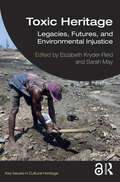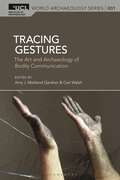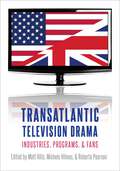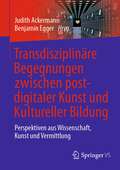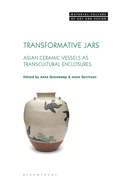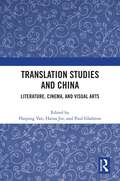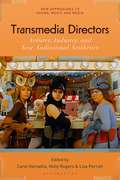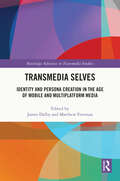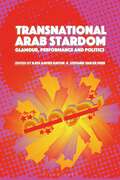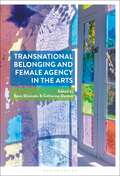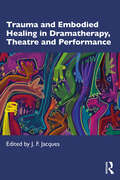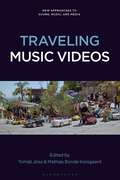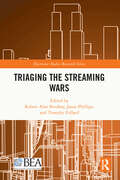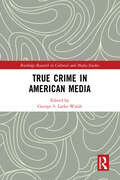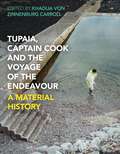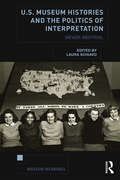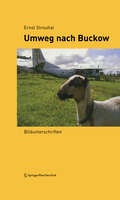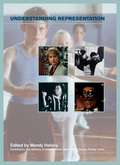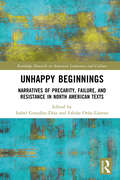- Table View
- List View
Toxic Heritage: Legacies, Futures, and Environmental Injustice (Key Issues in Cultural Heritage)
Toxic Heritage addresses the heritage value of contamination and toxic sites and provides the first in-depth examination of toxic heritage as a global issue. Bringing together case studies, visual essays, and substantive chapters written by leading scholars from around the world, the volume provides a critical framing of the globally expanding field of toxic heritage. Authors from a variety of disciplinary perspectives and methodologies examine toxic heritage as both a material phenomenon and a concept. Organized into five thematic sections, the book explores the meaning and significance of toxic heritage, politics, narratives, affected communities, and activist approaches and interventions. It identifies critical issues and highlights areas of emerging research on the intersections of environmental harm with formal and informal memory practices, while also highlighting the resilience, advocacy, and creativity of communities, scholars, and heritage professionals in responding to the current environmental crises. Toxic Heritage is useful and relevant to scholars and students working across a range of disciplines, including heritage studies, environmental science, archaeology, anthropology, and geography.
Tracey Emin: Art into Life
Tracey Emin has undergone an extraordinary metamorphosis from a young, unknown artist into the 'bad girl' of the Young British Art (yBA) movement, challenging the complacency of the art establishment in both her work and her life. Today she is arguably the doyenne of the British art scene and attracts more acclaim than controversy. Her work is known by a wide audience, yet rarely receives the critical attention it deserves.In Tracey Emin: Art Into Life, writers from a range of art historical, artistic and curatorial perspectives examine how Emin's art, life and celebrity status have become inextricably intertwined. This innovative collection explores Emin's intersectional identity, including her Turkish-Cypriot heritage, ageing and sexuality, reflects on her early years as an artist, and debates issues of autobiography, self-presentation and performativity alongside the multi-media exchanges of her work and the tensions between art and craft. With its discussions of the central themes of Emin's art, attention to key works such as My Bed, and accessible theorization of her creative practice, Tracey Emin: Art into Life will interest a broad readership.
Tracing Gestures: The Art and Archaeology of Bodily Communication (UCL World Archaeology Series)
This volume examines the role of gestures in past societies, exploring both how meaning was communicated through bodily actions, and also how archaeologists can trace the symbolism and significance of ancient gestures, ritual practices and bodily techniques through the material remnants of past human groups.Gesture studies is an area of increasing interest within the social sciences, and the individual chapters not only respond to developments in the field, but push it forward by bringing a wide range of perspectives and approaches into dialogue with one another. Each exhibits a critical and reflexive approach to bodily communication and to re-tracing bodies through the archaeological record (in art, the treatment of the body and material culture), and together they demonstrate the diversity of pioneering global research on gestures in archaeology and related disciplines, with contributions from leading researchers in Aegean, Mediterranean, Mesoamerican, Japanese and Near Eastern archaeology. By bringing case studies from each of these different cultures and regions together and drawing on interdisciplinary insights from anthropology, sociology, psychology, linguistics, design, art history and the performing arts, this volume reveals the similarities and differences in gestures as expressed in cultures around the world, and offers new and valuable perspectives on the nature of bodily communication across both space and time.
Transatlantic Television Drama: Industries, Programs, and Fans
In 2014, the UK science-fiction television series Black Mirror was released on Netflix worldwide, quickly becoming a hit with US audiences. Like other beloved British imports, this series piqued Americans' interest with hints of dark comedy, clever plotlines, and six-episode seasons that left audiences frantic for more. In Transatlantic Television Drama, volume editors Michele Hilmes, Matt Hills, and Roberta Pearson team up with leading scholars in TV studies and transnational television to look at how serial dramas like Black Mirror captivate US audiences, and what this reveals about the ways Americans and Brits relate to each other on and off the screen. Focusing on production strategies, performance styles, and audience reception, chapters delve into some of the most widely-discussed programs on the transatlantic circuit, from ongoing series like Game of Thrones, Downton Abbey, Orphan Black, and Sherlock, to those with long histories of transnational circulation like Masterpiece and Doctor Who, to others whose transnational success speaks to the process of exchange, adaptation, and cooperation such as Rome, Parade's End, Broadchurch, and Gracepoint. The book's first section investigates the platforms that support British/American exchange, from distribution partnerships and satellite providers to streaming services. The second section concentrates on the shift in meaning across cultural contexts, such as invocations of heritage, genre shifts in adaptation, performance styles, and, in the case of Episodes, actual dramatized depiction of the process of transatlantic television production. In section three, attention turns to contexts of audience reception, ranging from fan conventions and fiction to television criticism, the effects of national branding on audiences, and the role of social media in de- or re-contextualizing fans' response to transnational programs.
Transdisziplinäre Begegnungen zwischen postdigitaler Kunst und Kultureller Bildung: Perspektiven aus Wissenschaft, Kunst und Vermittlung
Postdigitale Kunstpraktiken bergen große Potenziale für die Kulturelle Bildung, da sie kreative Aneignungsformen im Kontext digitaler Technologien hervorbringen, neue Rezeptionserfahrungen kreieren und eine kritisch informierte Betrachtung von Digitalisierungsprozessen befördern. Dennoch sind sie bislang wenig erforscht und nehmen nur vereinzelt Eingang in Bildung und Vermittlung. Der Sammelband kombiniert theoretische Betrachtungen postdigitaler Kunst mit Projektberichten aus der Praxis, um Leser*innen die Möglichkeit zu geben, das Feld besser zu verstehen und Anwendungsideen für die eigenen Tätigkeitsbereiche zu entwickeln.
Transformative Jars: Asian Ceramic Vessels as Transcultural Enclosures (Material Culture of Art and Design)
The term 'jar' refers to any man-made shape with the capacity to enclose something. Few objects are as universal and multi-functional as a jar – regardless of whether they contain food or drink, matter or a void, life-giving medicine or the ashes of the deceased. As ubiquitous as they may seem, such containers, storage vessels and urns are, as this book demonstrates, highly significant cultural and historical artefacts that mediate between content and environment, exterior worlds and interior enclosures, local and global, this-worldly and otherworldly realms. The contributors to this volume understand jars not only as household utensils or evidence of human civilizations, but also as artefacts in their own right. Asian jars are culturally and aesthetically defined crafted goods and as objects charged with spiritual meanings and ritual significance. Transformative Jars situates Asian jars in a global context and focuses on relationships between the filling, emptying and re-filling of jars with a variety of contents and meanings through time and throughout space. Transformative Jars brings together an interdisciplinary team of scholars with backgrounds in curating, art history and anthropology to offer perspectives that go beyond archaeological approaches with detailed analyses of a broad range of objects. By looking at jars as things in the hands of makers, users and collectors, this book presents these objects as agents of change in cultures of craftsmanship and consumption.
Translation Studies and China: Literature, Cinema, and Visual Arts
Focusing on transculturality, this edited volume explores how the role of translation and the idea of (un)translatability in the transformative complementation of different civilizations facilitates the transcultural connection between Chinese and other cultures in the modern era. Bringing together established international scholars and emerging new voices, this collection explores the linguistic, social, and cultural implications of translation and transculturality. The 13 chapters not only discuss the translation of literature, but also break new ground by addressing the translation of cinema, performance, and the visual arts, which are active bearers of modern and contemporary culture that are often neglected by academics. Through an engagement with these diverse fields, the title aims not only to reflect on how translation has reproduced values, concepts, and cultural forms, but also to stimulate the emergence of new possibilities in the dynamic transcultural interplay between China and the diverse national, cultural-linguistic, and contexts of Europe, the Americas, and Asia. It shows how cultures have been appropriated, misunderstood, transformed, and reconstructed through processes of linguistic mediation, as well as how knowledge, understanding, and connections have been generated through transculturality. The book will be a must read for scholars and students of translation studies, transcultural studies, and Chinese studies.
Transmedia Directors: Artistry, Industry and New Audiovisual Aesthetics (New Approaches to Sound, Music, and Media)
Transmedia Directors focuses on artist-practitioners who work across media, platforms and disciplines, including film, television, music video, commercials and the internet. Working in the age of media convergence, today's em/impresarios project a distinctive style that points toward a new contemporary aesthetics. The media they engage with enrich their practices – through film and television (with its potential for world-building and sense of the past and future), music video (with its audiovisual aesthetics and rhythm), commercials (with their ability to project a message quickly) and the internet (with its refreshed concepts of audience and participation), to larger forms like restaurants and amusement parks (with their materiality alongside today's digital aesthetics). These directors encourage us to reassess concepts of authorship, assemblage, transmedia, audiovisual aesthetics and world-building. Providing a vital resource for scholars and practitioners, this collection weaves together insights about artist-practitioners' collaborative processes as well as strategies for composition, representation, subversion and resistance.
Transmedia Selves: Identity and Persona Creation in the Age of Mobile and Multiplatform Media (Routledge Advances in Transmedia Studies)
This book examines the mediated shift in the contemporary human condition, focusing on the ways in which we synthesise with media content in daily life, essentially transmediating ourselves into new forms and (re)creating ourselves across media. Across an international roster of essays, this book establishes a transdisciplinary theory for the ‘transmedia self’, exploring how technological ubiquity and digital self-determination combine with themes and disciplines such as celebrity culture, fandom, play, politics, and ultimately broader self-conception and projection to inform the creation of transmedia identities in the twenty-first century. Specifically, the book repositions transmediality as key to understanding the formation of identity in a post-digital media culture and transmedia age, where our lives are interlaced, intermingled, and narrativised across a range of media platforms and interfaces. This book is ideal for scholars and students interested in transmedia storytelling, cultural studies, media studies, sociology, philosophy, and politics.
Transnational Arab Stardom: Glamour, Performance and Politics
Building on the work of star studies scholars, this collection provides contextual analyses of off-screen representation, as well as close textual analyses of films and star personas, thereby offering an in-depth study of the Arab star as text and context of Arab cinema. Using the tools of audience reception studies, the collection will also look at how stars (of film, stage, screen and new media) are viewed and received in different cultural contexts, both within and outside of the Arabic-speaking world.Arab cinema is often discussed in terms of political representation and independent art film, but rarely in terms of stardom, glamour, performance or masquerade. Aside from a few individual studies on female stardom or aspects of Arab masculinity, no major English-language study on Arab stardom exists, and collections on transnational stars or world cinema also often neglect to include Arab performers. This new book seeks to address this gap by providing the first study dedicated entirely to stardom on the Arab screen.Structured chronologically and thematically, this collection highlights and explores Arab film, screen and music stars through a transnational and interdisciplinary set of contributions that draw on feminist, performance and film theories, media studies, sound studies, material culture, queer star and celebrity studies, and social media studies.
Transnational Belonging and Female Agency in the Arts
Transnational Belonging and Female Agency in the Arts interrogates the politics of space expressed via womxn's artistic practices, which prioritise solidarity and collaboration across borders, imagining attentive geographies of difference. It considers belonging as a manifestation of processes of becoming that traverse borders and generate new spaces and forms of difference. In doing so, the book aims to catalyse mutual social relations founded upon responsibility and response-ability to each other. The transnational framework activates concerns around belonging at a time of intensified divisions, partitioning global narratives, unequal trajectories and increasing violence against bodies of the most vulnerable, largely founded on Eurocentric paradigms of political, economic and cultural superiority. The contributors engage in a conversation signalling transversal thinking and artmaking in order to articulate and activate 'in-between' spaces. This is to welcome co-affective models of belonging that question versatile embodiments of subjectivity as both agentic and as interrelational. Organised around the triangulation of modes of belonging: spatial, affective and collective, overarched by a transnational lens that acknowledges non-hierarchical, local and socially relevant genealogies against universalising politics of globalisation, these essays consider afresh ways in which female agency disrupts borders and activates concerns around different forms of belonging, citizenship and transnationalisms.Cover Image credit: Keren Anavy, Garden of Living Images (2018), general installation view (detail). Courtesy of the artist and Wave Hill. Photographer: Stefan Hagen
Trapeze act (Large Print)
This page shows two trapeze artists performing their act. They are seen from the side so each of them has only one arm and leg visible. Also on the page, there are two supporting towers, two trapezes and a safety net. The scene has a dashed line image border. There is a locator dot shown, which will be at the top left of the page when the image is the right way up. At the top of the page the ropes of the two trapezes can be found hanging. They are attached to points above, which cannot be found as they are outside the image border. In the centre of the page are the two small images of the performers. The one to the left hangs upside down with his legs hooked over the trapeze with his head to the right and his arm down the page. The performer to the right is flying horizontally through the air with his arm to the left, his hand ready to grasp the hand of the other artist. To the right of his arm are his head, chest and leg. His lower leg and foot point up the page. On the left and right of the page are two towers with a safety net, seen from the side, stretched between them. At the bottom of the page is the ground.
Trapeze act (UEB Contracted)
This page shows two trapeze artists performing their act. They are seen from the side so each of them has only one arm and leg visible. Also on the page, there are two supporting towers, two trapezes and a safety net. The scene has a dashed line image border. There is a locator dot shown, which will be at the top left of the page when the image is the right way up. At the top of the page the ropes of the two trapezes can be found hanging. They are attached to points above, which cannot be found as they are outside the image border. In the centre of the page are the two small images of the performers. The one to the left hangs upside down with his legs hooked over the trapeze with his head to the right and his arm down the page. The performer to the right is flying horizontally through the air with his arm to the left, his hand ready to grasp the hand of the other artist. To the right of his arm are his head, chest and leg. His lower leg and foot point up the page. On the left and right of the page are two towers with a safety net, seen from the side, stretched between them. At the bottom of the page is the ground.
Trapeze act (UEB uncontracted)
This page shows two trapeze artists performing their act. They are seen from the side so each of them has only one arm and leg visible. Also on the page, there are two supporting towers, two trapezes and a safety net. The scene has a dashed line image border. There is a locator dot shown, which will be at the top left of the page when the image is the right way up. At the top of the page the ropes of the two trapezes can be found hanging. They are attached to points above, which cannot be found as they are outside the image border. In the centre of the page are the two small images of the performers. The one to the left hangs upside down with his legs hooked over the trapeze with his head to the right and his arm down the page. The performer to the right is flying horizontally through the air with his arm to the left, his hand ready to grasp the hand of the other artist. To the right of his arm are his head, chest and leg. His lower leg and foot point up the page. On the left and right of the page are two towers with a safety net, seen from the side, stretched between them. At the bottom of the page is the ground.
Trauma and Embodied Healing in Dramatherapy, Theatre and Performance
This edited volume explores the singularity of embodiment and somatic approaches in the healing of trauma from a dramatherapy, theatre and performance perspective.Collating voices from across the fields of dramatherapy, theatre and performance, this book examines how different interdisciplinary and intercultural approaches offer unique and unexplored perspectives on the body as a medium for the exploration, expression and resolution of chronic, acute and complex trauma as well as collective and intergenerational trauma. The diverse chapters highlight how the intersection between dramatherapy and body-based approaches in theatre and performance offers additional opportunities to explore and understand the creative, expressive and imaginative capacity of the body, and its application to the healing of trauma.The book will be of particular interest to dramatherapists and other creative and expressive arts therapists. It will also appeal to counsellors, psychotherapists, psychologists and theatre scholars.
Traveling Music Videos (New Approaches to Sound, Music, and Media)
Traveling Music Videos offers a new interdisciplinary perspective on how contemporary music videos travel across, shape, and transform various media, online platforms, art institutions, and cultural industries worldwide. With the onset of digital technologies and the proliferation of global video-sharing websites at the beginning of the 21st century, music video migrated from TV screens to turn instead to the internet, galleries, concert stages, and social media. As a result, its aesthetics, technological groundings, and politics have been radically transformed. From the kinaesthetic experience of TikTok to the recent reimaginations of maps and navigation tools through music video cartographies, from the ecofeminist voices mediated by live-stream concerts to the transmedia logic of video games and VR, from the videos' role in contemporary art galleries to their political interventions -the chapters map the ways music video is continually reconfiguring itself. The volume tracks music video's audiovisual itineraries across different geographies, maps its transmedia routes, and tackles the cultural impact that it has on our current media ecosystem.
Triaging the Streaming Wars (ISSN)
This volume considers the different implications of the rise of streaming services and their particular acceleration during the COVID-19 pandemic. Exploring the significant disruption caused to the entertainment industries by the rise of these streaming services, a team of international scholars examine changes to labor issues and compensation, which were central to the conflict between the Writers Guild of America members and their agents, the broadening divide between networks and affiliates, the significant consolidation of the media industry resulting from Disney’s acquisition of Fox ahead of the launch of Disney+, and the variety of business models behind these services that defy the traditional advertising models and standard revenue streams. This thorough and multifaceted look at this rapidly growing section of the entertainment industry will be of interest to academics and students working in film and TV studies, media industry studies, digital media studies, business, and communication studies.
True Crime in American Media (Routledge Research in Cultural and Media Studies)
This book explores contemporary American true crime narratives across various media formats. It dissects the popularity of true crime and the effects, both positive and negative, this popularity has on perceptions of crime and the justice system in contemporary America. As a collection of new scholarship on the development, scope, and character of true crime in twenty-first century American media, analyses stretch across film, streaming/broadcast TV, podcasts and novels to explore the variety of ways true crime pervades modern culture. The reader is guided through a series of interconnected topics, starting with an examination of the contemporary success of true crime, the platforms involved, the narrative structures and engagement with audiences, moving on to debates on representation and the ethics involved in portraying both victims and perpetrators of crime within the genre. This collection provides new critical work on American true crime media for all interested readers, and especially scholars and students in the humanities and social sciences. It offers a significant area of research in social sciences, criminology, media and English Literature academic disciplines.
Tupaia, Captain Cook and the Voyage of the Endeavour: A Material History
Centring priest and navigator Tupaia and Pacific worldviews, this richly illustrated volume weaves a new set of cultural histories in the Pacific, between local islanders and the crew of the Endeavour on James Cook's first 'voyage of discovery' (1768-1771). Contributors consider material collections brought back from the voyage, paying particular attention to Tupaia's drawings, maps, cloth and clothes, and the attending narratives that framed Britain's engagement with Pacific peoples. Bringing together indigenous and Pacific-based artists, scholars, historians, theorists and tailors, this book presents a cross-cultural conversation around the concepts of acquired and curated artefacts that traversed oceans and entwined cultures. Each chapter draws attention to a particular material, object or process to reveal fresh insights on the voyage, the societies it brought together and the histories it transformed. Authors also explore animal iconography, instruments and ethnomusicology, and performances and rituals. This work challenges colonial museum collections and celebrations of Cook's voyages, using materials old and new to make connections between past and present, whilst reinforcing Tupaia's agency as both a historical figure and a contemporary muse. Tracing overlapping folds of symbolism, this book draws together a picture of the diverse materials and people at the centre of cultural exchange.
U.S. Museum Histories and the Politics of Interpretation: Never Neutral (Museum Meanings)
U.S. Museum Histories and the Politics of Interpretation is the first collection to examine the history of museums in the United States through the lens of the political and ideological underpinnings at the heart of exhibitions, collecting, and programming.Including contributions from historians, art historians, anthropologists, academics, and museum professionals, the book argues that museums have always been embedded in the politics and culture of their time – whether that means a reification of hegemonic notions of race, gender, and progress or a challenge to those normative structures. Contributions probe the political nature of collection and interpretation as concept and practice, and museum work as both reflective of and contributing to the politics and circulation of power in different historical moments. As a whole, the volume provides detailed readings of museums that demonstrate the ways in which these trusted cultural institutions have intervened in shifting concepts of nation, community, indigeneity, race, citizenship, inclusion, identity, localism, and memory.U.S. Museum Histories and the Politics of Interpretation makes arguments about the historically and politically rooted nature of cultural production in museums that apply to institutions across the globe. It is essential reading for students and scholars of museum studies, public history, cultural history, art history, and memory.
Umweg nach Buckow: Bildunterschriften (Edition Transfer)
„Umweg nach Buckow" enthält eine Vielzahl von Essays Ernst Strouhal’s aus den letzten Jahren, die sich der Themen Literatur, Spiel, Kunst, Politik und Reise annehmen. Auf unterschiedliche Art und Weise tragen die Texte, die sich programmatisch als „Bildunterschriften" verstehen, dem zusehends beliebigen „iconic turn" in den Medien und Kulturwissenschaften Rechnung, und reflektieren diesen kritisch. Auch wenn sich der Blick des Autors jeweils am Detail des Bildes und der Quelle entwickelt, so gilt das Interesse der Gegenwart. Das Spektrum des Bandes ist weit: Es reicht von der Begegnung des Autors mit Defoes Robinson, über Fragonard und die Kunst der Rätselmacher bis Arnold Schönberg, Marcel Duchamp und Bert Brecht.
Understanding Authenticity in Chinese Cultural Heritage (Routledge Research on Museums and Heritage in Asia)
Understanding Authenticity in Chinese Cultural Heritage explores the construction of "authenticity" and its consequences in relation to Chinese cultural heritage—those objects, texts, and intangible practices concerned with China’s past. Including contributions from scholars around the world reflecting on a range of different materials and time periods, Understanding Authenticity emphasizes the situatedness and fluidity of authenticity concepts. Attitudes toward authenticity change over time and place, and vary between communities and object types, among stakeholders in China as they do elsewhere. The book examines how "authenticity" relates to four major aspects of cultural heritage in China—art and material culture; cultural heritage management and preservation; living and intangible heritage; and texts and manuscripts—with individual contributions engaging in a critical and interdisciplinary conversation that weaves together heritage management, art history, archaeology, architecture, tourism, law, history, and literature. Moving beyond conceptual issues, the book also considers the practical ramifications for work in cultural heritage management, museums, and academic research. Understanding Authenticity in Chinese Cultural Heritage provides an opportunity for reflection on the contingencies of authenticity debates - not only in relation to China, but also anywhere around the world. The book will be of interest to scholars and students in a variety of fields, including heritage studies, Asian studies, art history, museum studies, history, and archaeology.
Understanding Representation (Understanding the Moving Image)
This is the third book in the 'Understanding the Moving Image' series. Like other books in the series, it aims to provide a strong critical and theoretical base for the study of the media. It has been co-authored by experienced Media and Film Studies tutors, offering fresh and innovative ways of talking about the key concept of representation. How is the world mediated to deliver messages and create beliefs about groups such as the mentally ill, institutions like the family and schools, minority and marginalised people and issues of nation seen through football and films? It also looks outside our ethnocentric mediated world to see how we are represented to others. The choice of texts reflects both an attempt to push the boundaries of the study of representation with new research, but also to make it accessible and stimulating for students coming into this area for the first time. Case studies reflect contemporary concerns in the media, often from different perspectives.
Understories: Plants and Culture in the American Tropics (American Tropics: Towards a Literary Geography #9)
Understories: Plants and Culture in the American Tropics establishes the central importance of plants to the histories and cultures of the extended tropical region stretching from the U.S. South to Argentina. Through close examination of a number of significant plants – cacao, mate, agave, the hevea brasilensis, kudzu, the breadfruit, soy, and the ceiba pentandra, among others – this volume shows that vegetal life has played a fundamental role in shaping societies and in formulating cultural and environmental imaginaries in and beyond the region. Drawing on a wide range of cultural traditions and forms across literature, popular music, art, and film, the essays included in this volume transcend regional and linguistic boundaries to bring together multiple plant-centred histories or ‘understories’ – narratives that until now have been marginalized or gone unnoticed. Attending not only to the significant influence of humans on plants, but also of plants on humans, this book offers new understandings of how colonization, globalization, and power were, and continue to be, imbricated with nature in the American tropics.
Unhappy Beginnings: Narratives of Precarity, Failure, and Resistance in North American Texts (Routledge Research in American Literature and Culture)
This book offers the analysis of a selection of North American texts that dismantle and resist normative frames through the resignification of concepts such as unhappiness, precarity, failure, and vulnerability. The chapters bring to the fore how those potentially negative elements can be refigured as ambivalent sites of resistance and social bonding. Following Sara Ahmed’s rereading of happiness, other authors such as Judith Butler, Wendy Brown, Jack Halberstam, Lauren Berlant, or Henry Giroux are mobilized to interrogate films, memoirs, and novels that deal with precarity, alienation, and inequality. The monograph contributes to enlarging the archives of unhappiness by changing the focus from prescribed norms and happy endings to unruly practices and unhappy beginnings. As the different contributors show, unhappiness, precarity, vulnerability, or failure can be harnessed to illuminate ways of navigating the world and framing society that do not necessarily conform to the script of happiness—whatever that means.
